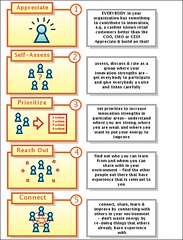
- Image by Alex Osterwalder via Flickr
Discussing the three kinds of interventions associated with transformational change, namely: culture change, self-design, and Organizational Learning and Knowledge management.
Culture change: focuses more on the development of a strong, appropriate culture for the line of business, environment, workforce demographics and societal norms as a way to align organizations, mission and processes. Its central concerns are: behaviors, values, beliefs and norms. A rush to judgment premature characterization of cultural type in implications are frequent shortcomings of a naïve approach to cultural management. A distinction should be made between culture and climate in which culture represents weather patterns that are slow to change, while climate represents today’s temperature and humidity in which may be quickly identified and adapt to. It’s not clear that cultures can be managed; shine advises tempering your expectations pragmatically.
Self design: is a highly participative process incorporating multiple stakeholders who are empowered to set directions and then design and implement structures and processes that are appropriate for their situation. There is an educational component for both process and content to empower and enable stakeholders to take on the design and implementation tasks. Self design is any iterative and integrated approach with three basic phases: laying the foundation in which knowledge is acquired and then used to diagnose and reaffirm values; the design phase in which a new structure and set of processes emerge from the foundation; and finally implementing and assessing the results. This system of phases with feedback loops very much resembles traditional action research and action learning and the ideal Deming plan do check act sequence.
Organizational learning and knowledge management: combines two interrelated change processes: organizational learning which examines how an organization acquires and develops new knowledge, and knowledge management, which is focused on how that knowledge is then organized and applied to improve performance. It’s possible for this intervention to go beyond solving existing problems and proactively support continuous improvement. A central concern in learning organizations is the idea of formalizing for extracting the tacit knowledge residing in the hearts and minds of the workforce in translating that into an accessible enterprise knowledge database to support continuous improvement. Knowledge engineering, and knowledge navigation and cognitive task analysis are enabling skills needed for this endeavor.
Infrastructure, policies, education, resourcing the support staff, architecture, tagging and search are all essential elements of a knowledge management and organizational learning plan. Measuring the costs of creating, managing and applying the knowledge is nontrivial. Estimating the value of tacit knowledge in order to justify a given expenditure of resources to extract it is problematic. The buy-in of leadership, like all interventions, is important as well. A focus on hardware and software will often overshadow the all-important middleware or wetware residing between our ears. It may be more important to examine how we learn than optimizing the tools by which we will store the information we have created.
Our college is going through an institution wide approach to knowledge management in which we are making all of the possible errors noted in the book. An excessive focus on technology and hardware at the expense of how the end users actually use knowledge and what their particular needs are is evident from the first day of planning. Having the IT department director as the project lead pretty much guarantees that approach would be taken. He is looking for a technology driven, centrally managed, high cost solution, whereas the student and faculty representatives are much more interested in a robust set of diverse practices that support their particular and unique needs.
It’s not clear yet how we will bridge these competing values.
Related articles by Zemanta
- ft lvn (kansasreflections.wordpress.com)
- Boundary spanning – knowledge across (slideshare.net)
- Leadership Functions And Organizational Learning In Tecnalia Javier Ruiz (slideshare.net)
- Fwd: Tacit Knowledge Retrieval (academic-practice.blogspot.com)
- Agility Webinar 1028 (slideshare.net)
- Recommended book: Jennifer Sertl’s Strategy Leadership and the Soul (book review) (fredzimny.wordpress.com)
- Positive Deviance: A Case Study in Finding and Harnessing the Wisdom of Organizational Communities (tc.eserver.org)
- Orl4820 marsolek m_week8_innovation plan (slideshare.net)
- Managing: Knowledge Management for Small Biz (womensblog.score.org)
- Sikm knowledge jam (katrina pugh) 100615 (slideshare.net)
- ft lvn (kansasreflections.wordpress.com)
- Boundary spanning – knowledge across (slideshare.net)
- Leadership Functions And Organizational Learning In Tecnalia Javier Ruiz (slideshare.net)
- Orl4820 marsolek m_week8_innovation plan (slideshare.net)
- Fwd: Tacit Knowledge Retrieval (academic-practice.blogspot.com)
- Recommended book: Jennifer Sertl’s Strategy Leadership and the Soul (book review) (fredzimny.wordpress.com)
- Managing: Knowledge Management for Small Biz (womensblog.score.org)
- Agility Webinar 1028 (slideshare.net)
- Positive Deviance: A Case Study in Finding and Harnessing the Wisdom of Organizational Communities (tc.eserver.org)
- Sikm knowledge jam (katrina pugh) 100615 (slideshare.net)
- ft lvn (kansasreflections.wordpress.com)
- Boundary spanning – knowledge across (slideshare.net)
- Leadership Functions And Organizational Learning In Tecnalia Javier Ruiz (slideshare.net)
- Orl4820 marsolek m_week8_innovation plan (slideshare.net)
- Fwd: Tacit Knowledge Retrieval (academic-practice.blogspot.com)
- Recommended book: Jennifer Sertl’s Strategy Leadership and the Soul (book review) (fredzimny.wordpress.com)
- Managing: Knowledge Management for Small Biz (womensblog.score.org)
- Agility Webinar 1028 (slideshare.net)
- Positive Deviance: A Case Study in Finding and Harnessing the Wisdom of Organizational Communities (tc.eserver.org)
- Sikm knowledge jam (katrina pugh) 100615 (slideshare.net)

